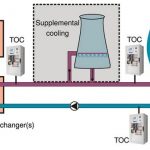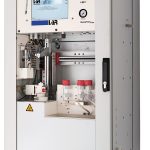Cooling processes and buildings plays an important role in industry. Some processes are simply not feasible without cooling. The failure of a cooling system can consequently bring production to a halt and result in significant losses. Application-specific online TOC (total organic carbon) analysers reduce this risk with indirect cooling systems.
Author Dr. Werner Arts President, LAR Process Analysers
Cooling water is used in almost every branch of industry as well as in power supply companies. The chemical industry, iron and steel and energy utilities have the highest demand for energy. The various cooling systems used have one thing in common: the cooling medium is water. The cooling methods can differ significantly in terms of design and the composition of the cooling medium. The most common methods in power plants and energy utilities – aside from mixed and special forms – are once-through or recirculative cooling, open-circuit cooling and closed-circuit cooling. In Germany the biggest proportion of cooling water is utilised for recirculative systems. These systems use water from receiving streams for one cycle through the heat exchanger. Afterwards, the heated water is fed back into the receiving stream, the sewage system or other processes. In order to reduce the thermal loads into the receiving stream, a cooling tower for supplemental cooling may follow. Open-circuit cooling systems always have a cooling tower and work based on the principle of evaporation. The aim is to avoid and/or reduce the thermal input into river water. Open-circuit cooling systems use pretreated feed water to prevent an inadmissible increase in the water’s salinity. In a closed-circuit cooling system direct contact between the cooling water and air is avoided. The heat of the cooling water is dissipated to air or water. Depending on its quality, the cooling water requires treatment to eliminate sedimentation, corrosion and/or biological growth.
Waste water volumes
Cooling water becomes waste water when it is pretreated using chemicals or its composition is changed by thickening or product spillage. The outlet therefore needs to be monitored. In addition, various regional regulations and industry-specific publications define discharge parameters such as pH, conductivity and chlo-ride content. TOC is recommended for detecting organic contaminants.
Regardless of the cooling system, the water is generally treated with microbiocides (e.g. chlorine, bromine) to prevent biological growth. Furthermore, conditioning agents may be added to stabilise the water hardness, keep particles floating or minimise corrosion. The aim, however, is to avoid excessive discharges of these substances into the receiving stream. The limits are mandatory and failure to respect them may lead to high penalties. Moreover, product spillages can cause contamination inside the heat exchanger. In this case, the cooling water will affect the product quality and vice versa. A deterioration in heat dissipation efficiency due to leakage and the high cost of discharging polluted cooling water must be ruled out. In order to determine organic loads in advance, online TOC measurements should be carried out at the influent of water as well as downstream of the heat exchangers. If impurities are detected in time, the contaminated cooling water can be redirected into buffer tanks, to avoid polluting the downstream cooling system and protect the production process.
Another waste water source is the cleaning process. Cleaning agents like lye solutions, acids, disinfectants or surfactant substances are used to remove sedimentation, biofilms and corrosion products. A continuous monitoring of the cooling water is therefore unavoidable when it comes to reducing cost-intensive waste water disposal. One remedy might be online monitoring for specific parameters such as TOC or toxicity, to avoid harmful effects on flora and fauna species residing in the rivers.
TOC analysis for proactive maintenance
Monitoring the cooling system is essential for an efficient production. The first step in proactive maintenance is therefore to monitor the influent. Any contaminants are detected early so that downstream heat exchangers can be protected.
In order to be able to take prompt action in case of impact loads (for example due to leakage), the results of the monitoring system have to be available very fast. Hence, laboratory monitoring is not recommended owing to the time-consuming analysis methods. Online analysers, on the other hand, deliver results within minutes.
Selecting the appropriate measurement system and taking it into account in the design processes is essential to ensure rapid results. It is advisable to install the analyser directly at the sampling point. There is thus no runtime and no sample mixing at the sampling port, both of which would falsify the measurements.
LAR’s QuickTOCultra series includes the ideal analyser for any cooling water challenge. Its robot driven xy-injection module takes a precise sample with a needle that moves both horizontally and vertically and injects it into the oven through a special valve. The needle is cleaned after every injection. Clogging or memory effects caused by substances with adhesive characteristics are thus avoided. All carbon bonds are dissolved and completely oxidised to CO2 at +1200°C in the catalyst-free oven. A detector then measures the CO2 concentration and determines the TOC content. The process controller used by the ultra series allows the TOC to be calculated in less than three min-utes. Even short peaks are recognised reliably. In addition, the modular system permits up to six sample streams to be measured in a single analyser, in other words the inlet and outlet of the cooling water system can be monitored using just one instrument. Differences in TOC due to leakage or product spillage, for example, are detected quickly.
Conclusion
Fast and accurate analysis of cooling water is unavoidable from both a legal and an eco-nomic point of view. The use of online measurement techniques combines high potential savings with increased safety on the production site. Reliable measurement results, for instance, enable the water to be reused if its quality is suitable and suitable action can be taken promptly in case of peak loads. Impor-tant production processes such as heat transfer by heat exchangers can be safeguarded efficiently. Moreover, precise online measurements facilitate proactive maintenance because the cooling system can be protected against contamination in advance. The risk of failures is reduced to a minimum.
Hall A5, Booth 111
cpp-net.com/0114417
Share:








